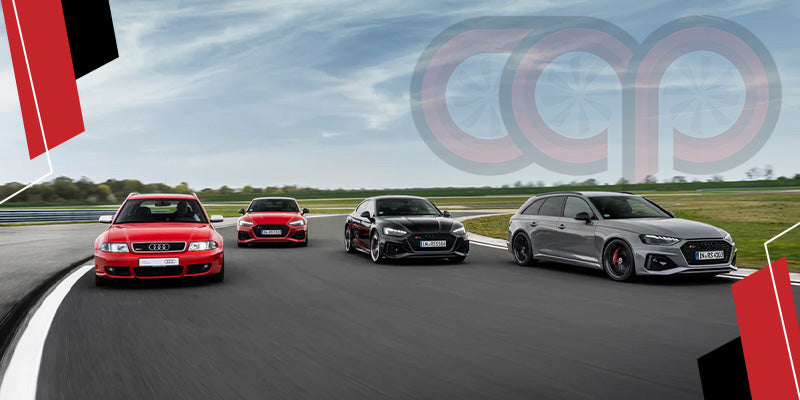
Account
Country
AUDI A8/S8/RS8
AUDI R8
Audi Q8/SQ8


The Audi S4 was conceived with a clear vision: to seamlessly blend the realms of luxury and high performance. This ambition was brought to life as Audi responded to the growing demand for vehicles that could offer the refinement of an executive saloon and the exhilarating performance of a sports car. The introduction of the S4 marked Audi's foray into this dynamic space, challenging the norms and setting new benchmarks.
In this article, we will explore the evolution of the Audi S4 through its various generations, from its inception to the present day. Each generation of the S4 represents a significant step forward in terms of performance, technology, and design. Join us as we take a journey through the history of the Audi S4 and discover how it has consistently redefined the expectations for performance luxury vehicles.
Related: Audi S6 Evolution

Launched in 1991, the original Audi S4, also known as Audi 100 S4, laid the foundation for Audi's entry into the high-performance saloon market. Based on the C4 platform, it was a successor to the Audi 200 turbo quattro 20V and marked a significant shift in Audi's approach to performance and luxury.

With the 1994 model line update and the transition from the Audi 100 to the A6 series, the S4 was rebranded as the S6. This period also saw the introduction of the "Plus" variants, notably more powerful and exclusive, featuring a 4.2-litre V8 engine, replacing the standard inline-five engine.

The original S4's heart was a 2.2-litre, 20-valve inline five-cylinder engine, delivering 227 bhp and a 0-100 km/h time of 6.2 seconds. It was offered with a choice of manual or automatic transmissions and was equipped with Audi's pioneering quattro four-wheel-drive system, ensuring exceptional handling and driving dynamics.
Related: Our Most Favorite Audi's To Modify

In 1997, Audi redefined the compact-executive sports car segment with the introduction of its second-generation S4. This model positioned itself as a formidable contender against rivals like the BMW M3 and Mercedes-Benz C36 AMG. Departing from its rally-oriented predecessor based on the Audi 100, the new S4 was built on the Audi A4 platform, signifying a strategic shift in Audi's approach to the competitive sports car market.
Aesthetically, the S4 maintained a subtle distinction from the regular A4, featuring 17” light-alloy wheels, redesigned bumpers, and discreet S4 branding. The interior catered to driving enthusiasts with sport-bucket front seats, while the rear bench-seat served more as a practical feature rather than a focal point.

Underneath, the S4 boasted a powerful 2.7-liter V6 twin-turbo engine, delivering its force to all four wheels through a 6-speed manual gearbox and a Torsen center differential. This setup underscored Audi's commitment to providing a dynamic and engaging driving experience for performance-oriented drivers.
Related: Best Mods For Audi S5 B9

In 2003, Audi unveiled the third-generation S4, based on the A4 B6 platform, which notably housed the largest engine ever fitted in an A4 by the factory. This model emerged as a key player in the intense German rivalry for sports car supremacy, a battle escalated in the same year by Mercedes' introduction of the E55 AMG. Audi's S4, available as a sedan, station wagon, and cabriolet, was designed to compete with the likes of the BMW M3 and Mercedes-Benz C32 AMG, showcasing its prowess with a formidable V8 engine and all-wheel drive.

The S4 subtly distinguished itself from the standard A4 with design elements like enlarged wheel arches and dual exhausts, hinting at its superior capabilities. The interior featured luxurious touches like leather bucket seats and an S4-branded instrument cluster. With transmission options including a 6-speed manual and a Tiptronic automatic, the S4 offered a dynamic driving experience powered by its 4.2-liter V8 engine.

This era marked an intense competitive race among German automakers, evident not only in their high-end sports models like the Audi RS6, BMW M5 V10, and Mercedes E55 AMG, but also in their more accessible counterparts such as the S4, BMW M3, and Mercedes C32 AMG. Characterized by an extraordinary push for power and performance, this period saw even non-sport model vehicles being offered with V8 configurations. This trend underscored the German commitment to engineering prowess and a spirited rivalry in the automotive industry.

The 2005 Audi S4 marked its presence alongside the new generation A4 and A4 Avant, presenting a fusion of subtle cosmetic revisions and mechanical continuity. Despite being considered a new model, most changes were aesthetic, with the S4 adopting the stylish and sportier design language of Audi's evolving lineup. It featured Audi's iconic large, trapezoidal singleframe grille, alongside refreshed side panels, clear-glass HID headlamps, redesigned tail lights, and quad exhaust pipes.

Inside, the 2005 S4 saw modest enhancements aimed at boosting luxury and practicality. The cabin boasted a new 3-spoke steering wheel with a refined metal finish, repositioned buttons for improved ergonomics, a stylishly restyled gear-stick, and a driver-oriented infotainment display.

Under the hood, the S4 carried over the 4.2-liter V-8 engine from the previous B6 chassis into the new B7 platform, delivering 339 hp. This engine choice, while not significantly altered, combined with the S4's weight of 1705 kg (3759 lbs), offered a visceral driving experience, particularly notable in models equipped with a manual transmission. The opportunity to control a naturally aspirated V8 with a manual gearbox and quattro all-wheel-drive system was a rare and exhilarating feature.
However, it's worth noting that these models weren't Audi's most reliable offerings. As of 2024, the appeal of the 2005 S4 has been somewhat diminished due to high maintenance costs associated with the V8 engine, as well as its lack of fuel efficiency. Consequently, these cars are less commonly retained by enthusiasts, highlighting a trade-off between the thrill of driving a manual, naturally aspirated V8 and the practical considerations of upkeep and fuel economy.

The 2008-2012 Audi S4, a jewel in the Audi A4 range, is not just another model – it's our most cherished version at Canadian Auto Performance, and for good reason. When Audi reintroduced the V6 in this generation, echoing the revered 2.7T of the second-gen S4, it sparked an exhilarating resurgence in the S4 lineage. This wasn't just a comeback; it was a revolution.

This iteration of the S4 was everything an enthusiast could dream of. It epitomized reliability – being nothing short of bulletproof. The inclusion of a supercharged 3.0-liter V6 was a stroke of genius, striking a perfect balance between raw power and efficiency. This powerplant wasn't just about numbers; it brought an exhilarating auditory experience. The supercharger's whine was not merely a sound; it was a call to the open road, an invitation to unleash the S4's full potential.

Visually, the S4 was a study in subtlety and style, based on the 8th generation A4. With its chromed grille and quad exhausts, it maintained a dignified appearance, but those in the know could spot its prowess. Inside, the S4 carried the legacy forward with a refined yet sporty cabin, featuring aluminum accents and sport-bucket seats.
But it's under the hood where the magic truly happens. The supercharged V6 was a marvel, offering a thrilling drive that was both fast and fuel-efficient. Combined with Audi's adaptive quattro all-wheel-drive system, the S4 delivered an unmatched driving experience, capable of adjusting torque distribution to suit any condition.

The 2008-2012 S4 continues to reign as a legend, backed by one of the largest and most passionate communities in the automotive world. Its popularity in the realm of mods and aftermarket parts is unparalleled, testament to its enduring appeal and the endless possibilities it offers for personalization and performance enhancement. This is not just an Audi S4; it's a symbol of automotive excellence and a beacon for car enthusiasts everywhere. Around the same time Audi also entered the market with their A5/S5 lineup, see Audi S5 evolution by year here.

The 2012 Audi S4, carrying forward the spirit of the B8 series, showcased a striking redesign amidst a global financial downturn. Its front was distinguished by wave-shaped LED headlights and Xenon lamps, set within a distinctive bumper and chromed grille. The sportiness was further pronounced by 18” light-alloy wheels.

Inside, luxury met sport with high-bolstered bucket seats featuring the S4 logo, a sporty flat-bottom steering wheel, and a practical 60/40 split-folding rear bench. Notably, under the hood, the 2012 S4 retained the acclaimed supercharged three-liter V6 engine from its B8 predecessor. This continuity in powertrain, offered with either a six-speed manual or a seven-speed automatic transmission, ensured that the S4 remained a thrilling drive, true to its lineage.
Related: The Achilles Heel : 3.0T Cats & Why You Need To Get Rid Of Them

The 2015 Frankfurt Motorshow saw the unveiling of the fifth-generation Audi A4, and within its lineup was the dynamic S4 variant.
Distinctive aluminum-look exterior mirror housings added a touch of visual flair to its streamlined profile. Notably, the S4 featured unique front bumper and apron designs, complemented by quad exhausts at the rear. A subtle lip-spoiler graced the trunk, hinting at its sporty character.

Under the hood, the S4 housed a potent direct-injected, turbocharged 3.0-liter V6 engine. This formidable powerplant was coupled with an 8-speed tiptronic gearbox featuring a torque converter. True to the S-model legacy, Audi's renowned all-wheel-drive system was standard, with an optional sport rear differential for those seeking an extra edge.

Performance was a highlight, with both the saloon and estate versions achieving sub-5.0-second 0-62mph times (4.7 and 4.9 seconds, respectively) and a limited top speed of 155mph. The transition from supercharged to turbocharged technology marked a pivotal shift, shedding approximately 75kg compared to its predecessors. This weight reduction resulted in curb weights of 1630kg for the saloon and 1675kg for the estate.
Beneath the surface, the four-wheel-drive chassis effectively distributed power in a default 40/60 front-to-rear split under normal driving conditions. However, it remained adaptable, capable of redirecting up to 70% of power to the front axle or 85% to the rear when the situation demanded.
Related: What Is A Downpipe & Do You Need One?

Embracing a fresh aesthetic, the B9.5 Audi S4 underwent a facelift in 2020, elevating its visual appeal. Notable exterior updates include distinctive aluminum-look exterior mirror housings, a refined front bumper, and redesigned apron details. These enhancements contribute to a sleek and modern profile, maintaining the S4's sporty identity.

Beneath the refined exterior lies a powerhouse—a turbocharged 3.0-liter V6 engine that exemplifies the S4's commitment to performance. Paired with an 8-speed tiptronic gearbox featuring a torque converter, the B9.5 ensures a dynamic and responsive driving experience. This powerful combination propels both the saloon and estate versions to achieve sub-5.0-second 0-62mph times, with a limited top speed of 155mph.
The B9.5 S4's driving dynamics are a testament to Audi's engineering prowess. The all-wheel-drive system, a hallmark of the S models, ensures optimal traction, with an optional sport rear differential available for enthusiasts seeking an extra edge. The transition from supercharged to turbocharged technology not only enhances performance but also results in a weight reduction of approximately 75kg compared to its predecessors, contributing to agile handling and improved efficiency.

Beyond the numbers, the B9.5 S4's driving experience is marked by precise steering, excellent cornering stability, and a chassis that seamlessly balances sportiness and luxury. The four-wheel-drive chassis effectively distributes power, maintaining a default 40/60 front-to-rear split under normal driving conditions. However, it remains adaptable, capable of redirecting up to 70% of power to the front axle or 85% to the rear when the situation demands.
As we explore the evolution of the Audi S4 across generations, the B9.5 stands as a testament to continuous refinement, seamlessly blending cutting-edge technology with the unmistakable S-model charisma.
Read Next: Benefits Of Adding A High Flowing Turbo Inlet | Audi 3.0T